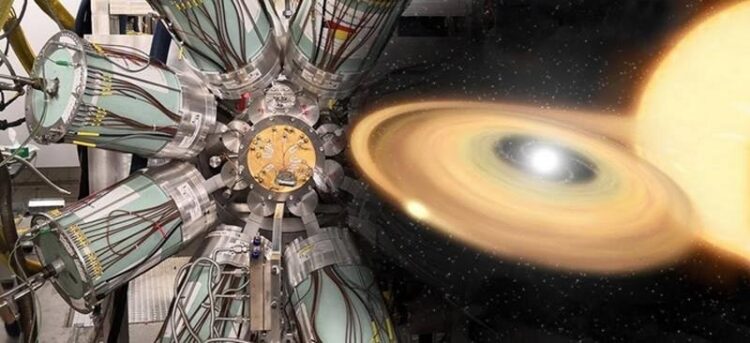Record-breaking radiation detection pins down element formation in stellar novae

The Gaseous Detector with Germanium Tagging (GADGET) used at the National Superconducting Cyclotron Laboratory for the present experiment (left). Artist’s depiction of an accreting white dwarf star prior to a nova explosion (right).
Image courtesy of the Facility for Rare Isotope Beams and NASA/JPL-Caltech
A weak proton emission following beta decay constrains the formation of elements in stellar nova explosions and determines their peak temperature.
The Science
Energy released by nuclear reactions drives exploding stars such as novae. To simulate novae accurately on computers, researchers need accurate inputs for the rates of nuclear reaction. The unknown rates of some nuclear reactions dramatically influence nova simulations. Nuclear physicists have now determined an important and challenging proton-capture reaction rate. Proton capture involves the collision of an atomic nucleus and one or more protons to create a heavier nucleus. The physicists did so by measuring the reverse proton emission in a laboratory. A state-of-the-art nova simulation incorporates the new experimental information. This allows physicists to compare the results to actual nova observations.
The Impact
Scientists’ current understanding of stellar novae hinges on the rate of the nuclear reaction that was the subject of this study. These new results enable scientists to determine the peak temperatures reached inside nova explosions. In addition, they allow scientists to make more accurate predictions of the isotopic ratios in stardust grains produced in novae. To make these measurements, nuclear physicists developed a new radiation detection system, the Gaseous Detector with Germanium Tagging (GADGET). GADGET detects protons following the beta decay of an unstable nucleus. The number of low-energy protons detected per beta decay in this experiment was the lowest ever measured. This result demonstrates the capability of the GADGET system for future investigations.
Summary
The National Superconducting Cyclotron Laboratory (NSCL), a user facility at Michigan State University, delivered a beam of the most neutron-deficient chlorine isotope, chlorine-31, to the GADGET system. GADGET measured the isotope’s beta decay to sulfur-31 for an experiment led by U.S. nuclear physicists with collaborators from Israel, Spain, China, South Korea, Canada, and France. Occasionally, the sulfur isotope emitted low-energy protons to produce phosphorus-30. The record-weak proton emission detected is the inverse of proton capture on phosphorus-30 in a nova explosion. These measurements enabled scientists to calculate the rate of proton capture on phosphorus-30 in a nova explosion. A nova simulation run in Spain incorporated the new knowledge acquired from these new results. Comparing the results of the simulation to the observed elemental abundances from actual novae now allows physicists a way to determine the peak temperature reached inside the explosion. These new measurements also suggest that novae from oxygen-neon white dwarfs produce excesses of the isotope silicon-30 from the decay of phosphorus-30. This information will be useful in identifying pre-solar stardust grains from novae in meteorites that solidified as the same time our solar system was forming.
Funding
This research was funded by the Department of Energy Office of Science, the National Science Foundation, the Natural Sciences and Engineering Research Council of Canada, the Spanish MINECO, the E.U. FEDER funds, the AGAUR/Generalitat de Catalunya, the E.U. Horizon 2020, and the Korean NRF. This article also benefited from discussions within the ChETEC COST Action.
Media Contact
Michael Church
DOE/US Department of Energy
michael.church@science.doe.gov
Office: 2028416299
All latest news from the category: Physics and Astronomy
This area deals with the fundamental laws and building blocks of nature and how they interact, the properties and the behavior of matter, and research into space and time and their structures.
innovations-report provides in-depth reports and articles on subjects such as astrophysics, laser technologies, nuclear, quantum, particle and solid-state physics, nanotechnologies, planetary research and findings (Mars, Venus) and developments related to the Hubble Telescope.
Newest articles

High-energy-density aqueous battery based on halogen multi-electron transfer
Traditional non-aqueous lithium-ion batteries have a high energy density, but their safety is compromised due to the flammable organic electrolytes they utilize. Aqueous batteries use water as the solvent for…

First-ever combined heart pump and pig kidney transplant
…gives new hope to patient with terminal illness. Surgeons at NYU Langone Health performed the first-ever combined mechanical heart pump and gene-edited pig kidney transplant surgery in a 54-year-old woman…

Biophysics: Testing how well biomarkers work
LMU researchers have developed a method to determine how reliably target proteins can be labeled using super-resolution fluorescence microscopy. Modern microscopy techniques make it possible to examine the inner workings…





















